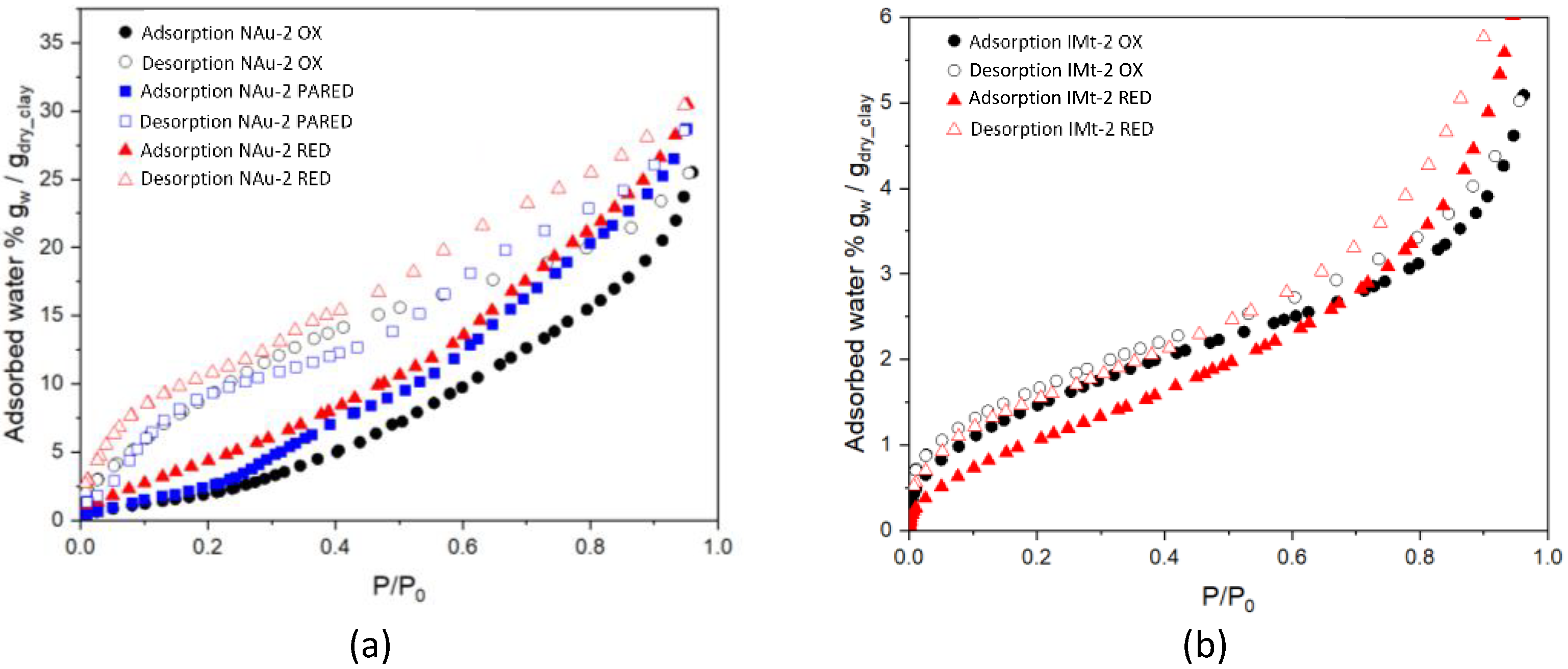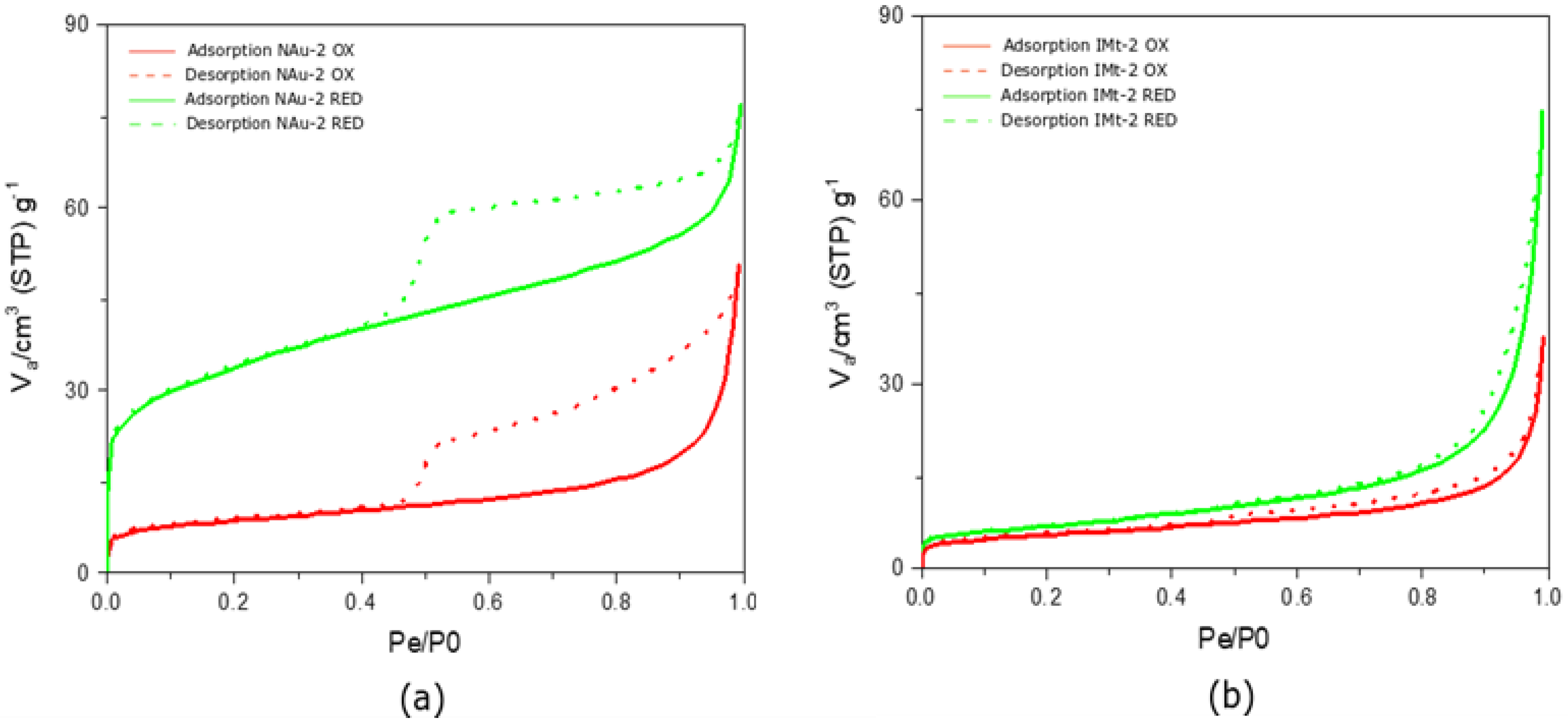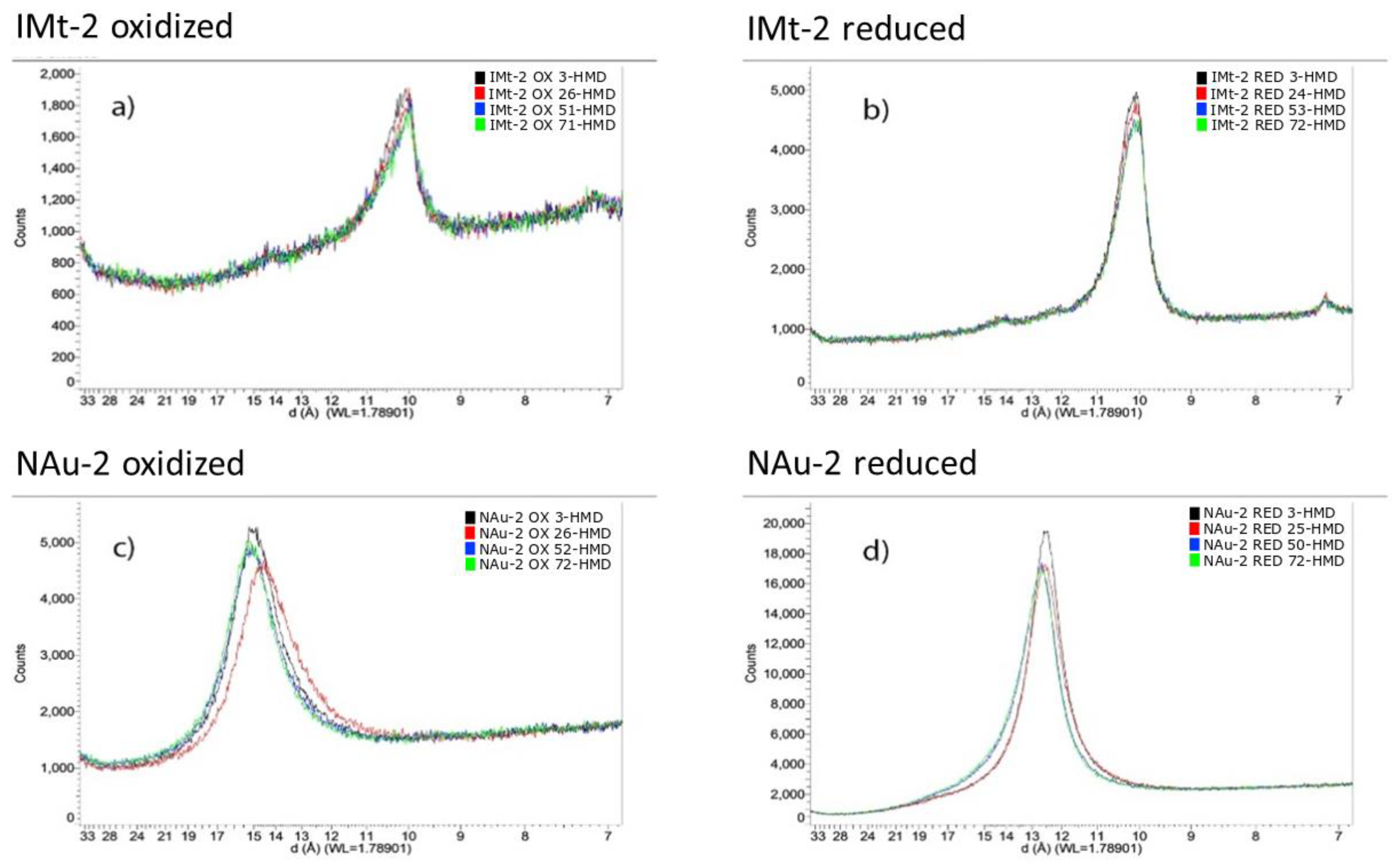Effect of Structural Fe Reduction on Water Sorption by Swelling and Non-Swelling Clay Minerals
Abstract
:1. Introduction
2. Materials and Methods
2.1. Clay Mineral Preparation and Fe(II)/Fe(III) Determination:
2.2. X-ray Diffraction Analysis
2.3. Water and Nitrogen Adsorption Measurements
2.4. Composition Analysis of Clay Minerals
3. Results
3.1. NAu-2 and IMt-2 Water Adsorption Isotherms
3.2. NAu-2 and IMt-2 Nitrogen BET Isotherms
3.3. X-ray Diffraction Analyses of Oxidised and Reduced NAu-2 and IMt-2 at Varying Relative Humidity
3.4. NAu-2 and IMt-2 Charge-Balancing Cation and Fe(II)/Fe(III) Composition
4. Discussion
4.1. Effect of Reduction and Clay Mineral Type on Water Vapour Adsorption of NAu-2 and IMt-2
4.2. Crystal Chemistry Controls on Hydration of NAu-2 and IMt-2 upon Reduction
4.3. Effect of Clay Mineral Fe Reduction on Nitrogen Adsorption to NAu-2 and IMt-2
5. Conclusions
Supplementary Materials
Author Contributions
Funding
Acknowledgments
Conflicts of Interest
References
- Binoy, S.; Raj, M.; Sammani, R.; Nanthi, B.; Sik, O.Y. The role of soils in the disposition, sequestration and decontamination of environmental contaminants. Philos. Trans. R. Soc. 2021, 376, 20200177. [Google Scholar]
- Strawn, D.G. Sorption mechanisms of chemicals in soils. Soil Syst. 2021, 5, 13. [Google Scholar] [CrossRef]
- Stucki, J.W.; Golden, D.C.; Roth, C.B. Effect of reduction and reoxidation of structural iron on the surface charge and dissolution of dioctahedral smectites. Clays Clay Miner. 1984, 32, 350–356. [Google Scholar] [CrossRef]
- Neumann, A.; Petit, S.; Hofstetter, T.B. Evaluation of redox-active iron sites in smectites using middle and near infrared spectroscopy. Geochim. Cosmochim. Acta 2011, 75, 2336–2355. [Google Scholar] [CrossRef] [Green Version]
- Gates, W.P.; Wilkinson, H.T.; Stucki, J.W. Swelling properties of microbially reduced ferruginous fmectite. Clays Clay Miner. 1993, 41, 360–364. [Google Scholar] [CrossRef]
- Stucki, J.W.; Tessier, D. Effects of iron oxidation state on the texture and structural order of Na-nontronite gels. Clays Clay Miner. 1991, 39, 137–143. [Google Scholar] [CrossRef]
- Thomas, M.D. Aqueous vapour pressure of soils. Soil Sci. 1921, 11, 409–434. [Google Scholar] [CrossRef]
- Thomas, M.D. Aqueous vapour pressure of soils: II Studies in dry soil. Soil Sci. 1921, 17, 1–18. [Google Scholar] [CrossRef]
- Josheph, A.F. The moisture equivalent of heavy soils II. J. Agric. Sci. 1927, 17, 12–20. [Google Scholar] [CrossRef]
- Anderson, M.S. The influence of substituted cations on the properties of soil colloids. J. Agric. Res. 1929, 38, 505–584. [Google Scholar]
- Foster, M.D. The relation between composition and swelling in clays. Clays Clay Miner. 1954, 3, 205–220. [Google Scholar] [CrossRef]
- Norrish, K. The swelling of montmorillonite. Faraday Discuss. 1954, 18, 120–134. [Google Scholar] [CrossRef]
- Zhang, Z.Z.; Low, P.F. Relation between the heat of immersion and the initial water content of Li-, Na-, and K-montmorillonite. J. Colloid Interface Sci. 1989, 133, 461–472. [Google Scholar] [CrossRef]
- Anderson, R.L.; Ratcliffe, I.; Greenwell, H.C.; Williams, P.A.; Cliffe, S.; Coveney, P.V. Clay swelling—A challenge in the oilfield. Earth-Sci. Rev. 2010, 98, 201–216. [Google Scholar] [CrossRef]
- Mooney, R.W.; Keenan, A.G.; Wood, L.A. Adsorption of water vapour by montmorillonite. II. Effect of exchangeable ions and lattice swelling as measured by X-ray Diffraction. J. Am. Chem. Soc. 1952, 74, 1371–1374. [Google Scholar] [CrossRef]
- Karaborni, S.; Smit, B.; Heidug, W.; Urai, J.; van Oort, E. The swelling of clays: Molecular simulations of the hydration of montmorillonite. Science 1996, 271, 1102–1104. [Google Scholar] [CrossRef] [Green Version]
- Hensen, E.J.M.; Smit, B. Why clays swell. J. Phys. Chem. B 2002, 106, 12664–12667. [Google Scholar] [CrossRef] [Green Version]
- Tardy, Y.; Touret, O. Hydration energies of smectites: A model for glauconite, illite and corrensite formation. Clay Conf. Denver 1987, 46–52. [Google Scholar] [CrossRef]
- Tardy, Y.; Fritz, B. An ideal solid solution model for calculating solubility of clay minerals. Clay Miner. 1981, 16, 361–373. [Google Scholar] [CrossRef]
- Tardy, Y.; Duplay, J. A Method of estimating the Gibbs free energies of formation of hydrated and dehydrated clay minerals. Geochim. Cosmochim. Acta 1992, 56, 3007–3029. [Google Scholar] [CrossRef]
- Smalley, M.V. Clay Swelling and Colloid Stability, 1st ed.; CRC Press: Boca Raton, FL, USA, 2006. [Google Scholar]
- Langmuir, I. The adsorption of gases on plane surfaces of glass, mica and platinum. J. Am. Chem. Soc. 1918, 40, 1361. [Google Scholar] [CrossRef] [Green Version]
- Brunauer, S.; Emmett, P.H.; Teller, E. Adsorption of gases in multimolecular layers. J. Am. Chem. Soc. 1938, 60, 309. [Google Scholar] [CrossRef]
- Keeling, J.L.; Raven, M.D.; Gates, W.P. Geology and characterization of two hydrothermal nontronites from weathered metamorphic rocks at the Uley graphite mine, South Australia. Clays Clay Miner. 2000, 48, 537–548. [Google Scholar] [CrossRef]
- Nieto, F.; Mellini, M.; Abad, I. The role of H3O+ in the crystal structure of illite. Clays Clay Miner. 2010, 58, 238–246. [Google Scholar] [CrossRef] [Green Version]
- Chang, P.H.; Li, Z.; Jean, W.T.; Wang, C.J.; Lin, K.H. Adsorption of tetracycline on 2:1 layered non-swelling clay mineral illite. Appl. Clay Sci. 2011, 67, 158–163. [Google Scholar] [CrossRef]
- Hillier, S. Use of an air brush to spray dry samples for X-ray powder diffraction. Clay Miner. 1999, 34, 127–135. [Google Scholar] [CrossRef]
- Omotoso, O.; McCarty, D.K.; Hillier, S.; Kleeberg, R. Some successful approaches to quantitative mineral analysis as revealed by the 3rd Reynolds Cup contest. Clays Clay Miner. 2003, 54, 748–760. [Google Scholar] [CrossRef]
- Butler, B.; Hillier, S. Automated full-pattern summation of X-Ray powder diffraction data for high-throughput quantification of clay-bearing mixtures. Clays Clay Miner. 2021, 69, 38–51. [Google Scholar] [CrossRef]
- Hillier, S. Quantitative analysis of clay and other minerals in sandstones by X-ray powder diffraction (XRPD). Int. Assoc. Sedimentol. Spec. Publ. 2003, 34, 213–251. [Google Scholar]
- Kuila, U.; Prasad, M. Specific surface area and pore—Size distribution in clays and shales. Geophys. Prospect. 2013, 61, 341–362. [Google Scholar] [CrossRef]
- Brunauer, S.; Deming, L.S.; Deming, W.E. On a theory of the van der Waals adsorption of gases. J. Am. Chem. Soc. 1940, 62, 1723–1732. [Google Scholar] [CrossRef]
- Hagymassy, J., Jr.; Brunauer, S.; Mikhail, R.S. Pore structure analysis by water vapour adsorption: I. t-curves for water vapour. J. Colloid Interface Sci. 1969, 29, 485–491. [Google Scholar] [CrossRef]
- McClellan, A.L.; Harnsberger, H.F. Cross-sectional areas of molecules adsorbed on solid surfaces. J. Colloid Interface Sci. 1967, 23, 577–599. [Google Scholar] [CrossRef]
- Sing, K.S.W. Reporting physisorption data for gas/solid systems with special reference to the determination of surface area and porosity. Pure Appl. Chem. 1982, 54, 2201–2218. [Google Scholar] [CrossRef]
- Patterson, A. The Scherrer Formula for X-Ray Particle Size Determination. Phys. Rev. 1939, 56, 978–982. [Google Scholar] [CrossRef]
- Stucki, J.W. A review of the effects of iron redox cycles on the properties of smectites. Geosci. Rep. 2011, 343, 199–209. [Google Scholar] [CrossRef]
- Ferrage, E.; Lanson, B.; Michot, L.J.; Robert, J.L. hydration properties and interlayer organization of water and ions in synthetic na-smectite with tetrahedral layer charge. Part 1. Results from X-ray diffraction profile modeling. J. Phys. Chem. C 2010, 114, 4515–4526. [Google Scholar] [CrossRef] [Green Version]
- Salles, F.; Douillard, J.M.; Denoyel, R.; Bildstein, O.; Julien, M.; Beurroies, I.; Van Damme, H. Hydration sequence of swelling clays: Evolutions of specific surface area and hydration energy. J. Colloid Interface Sci. 2009, 333, 510–522. [Google Scholar] [CrossRef]
- Wentworth, S.A. Illite. Clay Sci. 1970, 3, 140–155. [Google Scholar]
- Shen, S.; Stucki, J.W.; Boast, C.W. Effects of structural iron reduction on the hydraulic conductivity of Na-smectite. Clays Clay Miner. 1992, 40, 381–386. [Google Scholar] [CrossRef]
- Apeiranthitis, N.; Neumann, A.; Greenwell, H.C. Redox dependency of wettability of iron bearing clay minerals; implications for enhanced oil recovery. Energy Fuels 2022. in submission. [Google Scholar]
- Manceau, A.; Lanson, B.; Drits, V.A.; Chateigner, D.; Gates, W.P.; Wu, J.; Stucki, J.W. oxidation-reduction mechanism of iron in dioctahedral smectites: I. Crystal chemistry of oxidized reference nontronites. Am. Miner. 2000, 85, 133–152. [Google Scholar] [CrossRef]
- Stucki, J.W.; Komadel, P.; Wilkinson, H.T. Microbial reduction of structural iron(III) in smectites. Soil Sci. Soc. Am. J. 1987, 6, 1663–1665. [Google Scholar] [CrossRef]
- Gates, W.P.; Stucki, J.W.; Kirkpatrick, R.J. Structural properties of reduced Upton montmorillonite. Phys. Chem. Miner. 1996, 23, 535–541. [Google Scholar] [CrossRef]
- Kostka, J.E.; Wu, J.; Nealson, K.H.; Stucki, J.W. The impact of structural Fe(III) Reduction by Bacteria on the Surface Chemistry of Smectite Clay Minerals. Geochim. Cosmochim. Acta 1999, 63, 3705–3713. [Google Scholar] [CrossRef]
- Stucki, J.W.; Kostka, J.L. microbial reduction of iron in smectite. Comptes Rendus Geosci. 2006, 338, 468–475. [Google Scholar] [CrossRef]
- Favre, F.; Stucki, J.W.; Pascal, B. Redox properties of structural Fe in ferruginous smectite. A discussion of the standard potential and its environmental implications. Clays Clay Miner. 2006, 54, 466–472. [Google Scholar] [CrossRef]
- Lear, P.R.; Stucki, J.W. Effects of iron oxidation state on the specific surface area of nontronite. Clays Clay Miner. 1989, 37, 547–552. [Google Scholar] [CrossRef]
- Pons, C.H. Evidence of Relationships between Texture and Structure in Smectite Systems by Small Angle Synchrotron X-ray Scattering. Ph.D. Thesis, INIS, Dublin, Ireland, 1980. Volume 48. [Google Scholar]
- Haitlim, A.; Robert, M.; Tessier, R.; Prost, R. Influence of exchangeable cations (Na, Ca, Mg) and salt concentration on the physical properties (water retention, hydraulic conductivity) of montmorillonite. Agronomie 1984, 4, 451–459. [Google Scholar]
- Ben Rhaiem, H.; Tessier, D.; Pons, C.H. comportement hydrique et evolution structurale et texturale des montmorillonites au cours d’un cycle de dessiccation-humectation partie I cas des montmorillonites calciques. Clay Miner. 1986, 21, 9–29. [Google Scholar] [CrossRef]
- Touret, O. Structure of Hydrated Clays: Thermodynamics of Dehydration and Compaction of Smectites. Ph.D. Thesis, University of Strasbourg, Strasbourg, France, 1988. Available online: www.theses.fr/1988STR13026 (accessed on 10 May 2021).
- Kraehenbuehl, F.; Stoecki, H.F.; Brunner, F.; Kahr, G.; Muller-Vonmoos, M. Study of the water-bentonite system by vapour adsorption, immersion calorimetry and X-ray techniques: 1. micropore volumes and internal surface areas, following Dubinin’s theory. Clay Miner. 1987, 22, 1–9. [Google Scholar] [CrossRef]
- Środoń, J.; McCarty, D.K. Surface area and layer charge of smectite from CEC and EGME/H2O-retention measurements. Clays Clay Miner. 2008, 56, 155–174. [Google Scholar] [CrossRef]
- Mays, T.J. A New Classification of Pore Sizes; Llewellyn, P.L., Rodriquez-Reinoso, F., Rouqerol, J., Seaton, N., Eds.; Studies in Surface Science and Catalysis; Elsevier: Amsterdam, The Netherlands, 2007; Volume 160, pp. 57–62. [Google Scholar]
- Brindley, G.H.; Brown, G. Crystal structures of clay minerals and their X-ray identification. Mineral. Soc. Monogr. 1980, 5, 411–438. [Google Scholar]
- Cervini-Silva, J.; Larson, R.A.; Stucki, J.W. Hydration/expansion and cation charge compensation modulate the Brønsted basicity of distorted clay water. Langmuir 2006, 22, 2962–2965. [Google Scholar] [CrossRef] [PubMed]
- Underwood, T.; Erastova, V.; Greenwell, H.C. Ion adsorption at clay-mineral surfaces: The Hofmeister series for hydrated smectite minerals. Clays Clay Miner. 2016, 64, 472–487. [Google Scholar] [CrossRef] [Green Version]
- Rancourt, D.G.; Ping, J.Y. Voigt-based method for arbritrary-shape static hyperfine parameter distributions on Mössbauer-spectroscopy. Nucl. Instrum. Methods Phys. Res. B 1991, 58, 85–97. [Google Scholar] [CrossRef]
- Lagarec, K.; Rancourt, D.G. Recoil-Mössbauer Spectral Analysis Software for Windows; Department of Physics, University of Ottawa: Ottawa, ON, Canada, 1998. [Google Scholar]



| BET | |||
|---|---|---|---|
| Samples | Vm (cm3/g STP) | SSAw (m2/g) | CBET |
| IMT-2 OX | 17 | 68 | 23 |
| IMT-2 RED | 13 | 53 | 13 |
| NAu-2 OX | 28 | 115 | 8 |
| NAu-2 PARED | 36 | 140 | 8 |
| NAu-2 RED | 68 | 270 | 8 |
| Samples | Vm (STP) [cm3/g] | Specific Surface Area SSAN2 [m2/g] | BET C [Constant] | Mean Pore Diameter [nm] | Total Pore Volume (P/P0 = 0.99) [cm3/g] |
|---|---|---|---|---|---|
| NAu-2 OX | 7.2 | 31 | 240 | 9.5 | 0.074 |
| NAu-2 RED | 27.9 | 121 | 212 | 3.6 | 0.111 |
| IMt-2 OX | 4.5 | 20 | 198 | 11.0 | 0.054 |
| IMt-2 RED | 5.6 | 24 | 250 | 18.4 | 0.112 |
| BULK SAMPLE COMPOSITION | ||||||||
|---|---|---|---|---|---|---|---|---|
| Sample | Quartz | K-Feldspar | Plagioclase | Calcite | Anatase | Nontronite | Illite/Mica | Kaolinite |
| NAu-2 OX | 0.5 | - | - | - | - | 99.5 | - | - |
| IMt-2 OX | 17.1 | 4.9 | 0.3 | 0.3 | 0.6 | - | 76.3 | 0.5 |
| CLAY SIZE FRACTION COMPOSITION | ||||||||
| Illite | Smectite | Chlorite | Kaolinite | |||||
| NAu-2 OX | - | 100.0 | - | - | ||||
| IMt-2 OX | 99.0 | - | trace | 1.0 | ||||
| Sample | Ca2+ | Na+ | K+ | Overall Surface Charge |
|---|---|---|---|---|
| NAu-2 OX | 27.60 | 8.16 | 0.74 | 64.0 |
| NAu-2 RED | 4.11 | 84.33 | 1.50 | 94.0 |
| IMt-2 OX | 6.97 | 2.80 | 162.13 | 178.9 |
| IMt-2 RED | 2.01 | 14.23 | 163.99 | 182.3 |
Publisher’s Note: MDPI stays neutral with regard to jurisdictional claims in published maps and institutional affiliations. |
© 2022 by the authors. Licensee MDPI, Basel, Switzerland. This article is an open access article distributed under the terms and conditions of the Creative Commons Attribution (CC BY) license (https://creativecommons.org/licenses/by/4.0/).
Share and Cite
Vasilopanagos, C.; Carteret, C.; Hillier, S.; Neumann, A.; Brooksbank, H.J.L.; Greenwell, H.C. Effect of Structural Fe Reduction on Water Sorption by Swelling and Non-Swelling Clay Minerals. Minerals 2022, 12, 453. https://doi.org/10.3390/min12040453
Vasilopanagos C, Carteret C, Hillier S, Neumann A, Brooksbank HJL, Greenwell HC. Effect of Structural Fe Reduction on Water Sorption by Swelling and Non-Swelling Clay Minerals. Minerals. 2022; 12(4):453. https://doi.org/10.3390/min12040453
Chicago/Turabian StyleVasilopanagos, Christos, Cédric Carteret, Stephen Hillier, Anke Neumann, Harry J. L. Brooksbank, and Hugh Christopher Greenwell. 2022. "Effect of Structural Fe Reduction on Water Sorption by Swelling and Non-Swelling Clay Minerals" Minerals 12, no. 4: 453. https://doi.org/10.3390/min12040453
APA StyleVasilopanagos, C., Carteret, C., Hillier, S., Neumann, A., Brooksbank, H. J. L., & Greenwell, H. C. (2022). Effect of Structural Fe Reduction on Water Sorption by Swelling and Non-Swelling Clay Minerals. Minerals, 12(4), 453. https://doi.org/10.3390/min12040453







